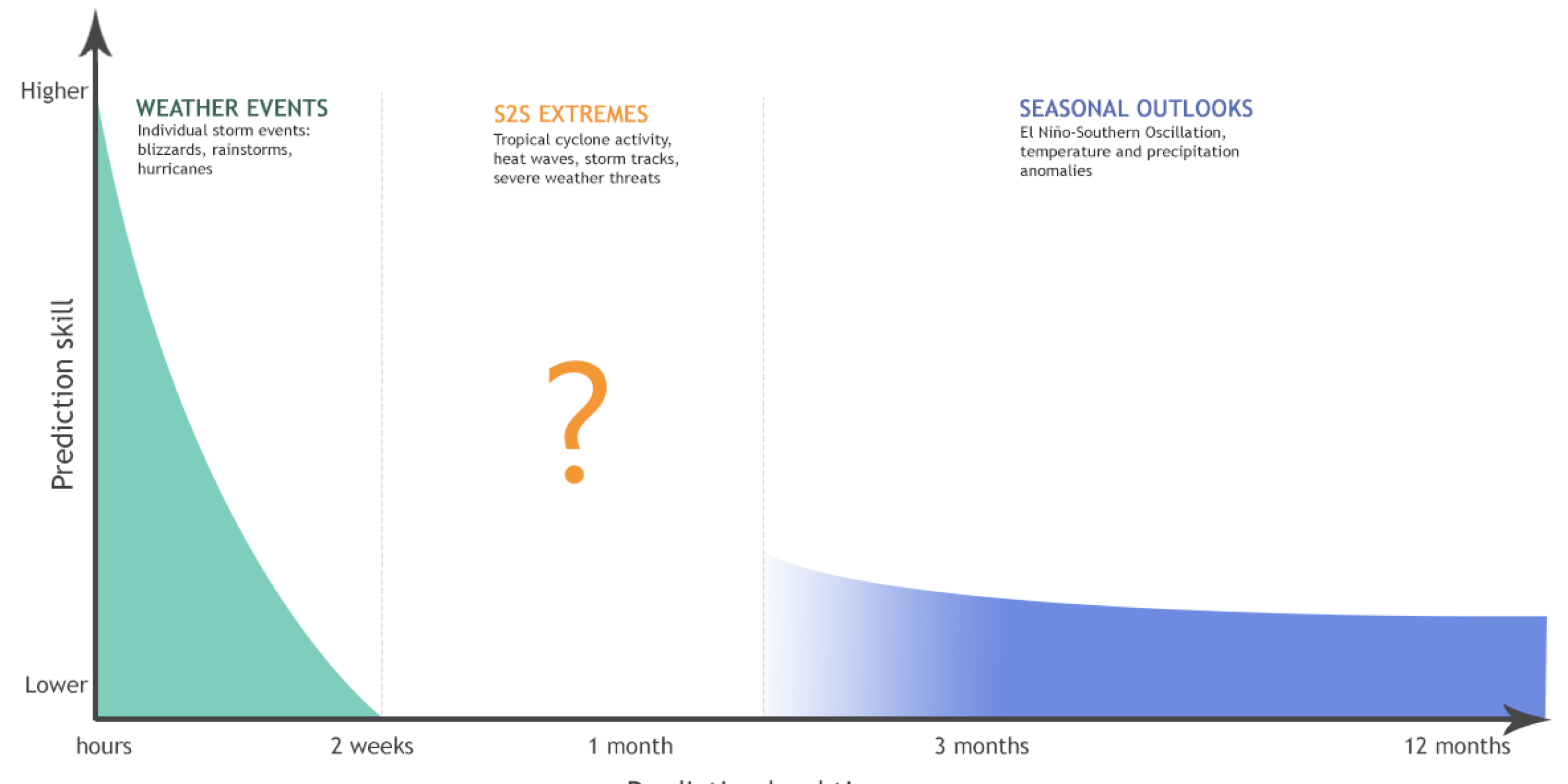To help advance the prediction of phenomena occurring on time scales between weather and seasonal predictions, NOAA’s Modeling, Analysis, Predictions, and Projections (MAPP) program—in partnership with the National Weather Service’s Office of Science and Technology—is funding 14 new three-year projects. These competitively funded projects involve $5.5 million in grants and $1.2 million in other awards (for a total of $6.7 million). With the background of a changing climate, NOAA strives to enhance community resilience in the face of weather and climate extremes. To help achieve this goal, NOAA scientists are seeking to extend the lead times at which they can skillfully predict extreme events such as heat waves, drought, and hurricanes. More advanced notice of extreme events would provide emergency managers, water resource managers, and decision makers in agriculture, health and other sectors more time to prepare and better allocate resources in order to safeguard life and property.
Traditionally, prediction efforts have primarily targeted the separate communities of either daily (“weather”) or seasonal lead times. The need to improve the ability to bridge weather and seasonal forecasts (between two weeks and two months), also known as the subseasonal to seasonal (S2S) prediction gap (see image), is recognized as a high priority both nationally and internationally. The 14 competitively selected three-year projects will help advance our capability to model sources of S2S predictability, enhancing NOAA’s ability to predict the threat of extremes such as heat waves, hurricanes, heavy rain, and extratropical cyclones at lead times beyond weather. The researchers leading these projects will constitute a new MAPP-organized Subseasonal to Seasonal Prediction Task Force – the purpose of which is to bring to bear the expertise of top scientists from both the weather and climate communities to help close the S2S prediction gap through enhanced communication and synergies. Additionally, the Task Force will provide a bridge between NOAA-driven activities and the broader national and international research community by collaborating with World Meteorological Agency (WMO) S2S Prediction Project. The S2S Prediction Project is a joint initiative of the WMO’s World Climate Research Programme (WCRP) and the World Weather Research Programme (WWRP) to advance research on forecasts between weather and climate timescales. This funding will complement internal investments towards S2S efforts at NOAA’s labs and centers of excellence across the U.S. The 141 new projects to be funded by the MAPP Program and in 2016 are:
- “The Relationship of Tropical Cyclones to MJO and ENSO in the S2S Database,” PI: Suzana Camargo (LDEO)
- “Prediction, Sensitivity, and Dynamics of Subseasonal to Seasonal Phenomena Diagnosed through Linear Inverse Models, their Adjoints, and Numerical Weather Prediction Models,” PI: Brett Hoover (UW-Madison CIMSS); co-PI: Matt Newman (ESRL/PSD)
- “Understanding the Sources of Subseasonal Predictability of Extratropical Cyclone Activity and Improving their Representation in Forecast Systems,” PI: Edmund Chang (Stony Brook University); co-PI: Wanqiu Wang (NCEP/CPC)
- “Collaborative Research: Assessing Oceanic Predictability Sources for MJO Propagation,” PI: Charlotte DeMott (Colorado State University); co-PI: Nicholas Klingaman (University of Reading)
- “Forecasting North Pacific Blocking and Atmospheric River Probabilities: Sensitivity to Model Physics and the MJO,” PI: Elizabeth Barnes (Colorado State University)
- “Madden Julian Oscillation – the Maritime Continent Barrier and Seamless Verification,” PI: Shuguang Wang (Columbia University)
- “Investigating the Underlying Mechanisms and Predictability of the MJO-NAM Linkage in the NMME Phase 2 Models,” PI: Jason Furtado (University of Oklahoma); co-PIs: Michelle L’Heureux (NCEP/CPC), Elizabeth Barnes (Colorado State University)
- “Exploring Pathways to Improve MJO Predictions,” PI: Arun Kumar (NCEP/CPC)
- “Improving Subseasonal to Seasonal Forecast Skill of North American Precipitation and Surface Air Temperature Using Multi-Model Strategy,” PI: Zhichang Guo (GMU/COLA)
- “North American Heat Wave Predictability: Assessing the Role of Land Surface Initialization on S2S and NMME Model Forecasts,” PI: Trent Ford (Southern Illinois University); co-PI: Paul Dirmeyer (GMU/COLA)
- “A Categorical Assessment of Forecast Skill, Uncertainty and Biases in Extended-Range Ensemble Forecasts of Stratospheric Regime Changes,” PI: Andrea Lang (University at Albany)
- “Variability of Rossby Wave Breaking and its Impacts on the Large-scale Circulation and Extreme Weather: Implications for S2S Prediction and Predictability,” PI: Zhuo Wang (University of Illinois at Urbana-Champaign)
- “Role of Stratospheric Processes in Predicting ENSO-NAO Connections on Subseasonal Time Scale,” PI: Judith Perlwitz (ESRL/PSD); co-PI: Jadwiga Richter (NCAR/CGD) “Investigation of the Effects of Oceanic Mesoscale Eddies on the Midlatitude Storm Tracks,” PI: Istvan Szunyogh (Texas A&M University)
1At the time of publication, all awards may not have been accepted by recipient institutions
MAPP is a program in the Climate Program Office, within NOAA’s Office of Oceanic and Atmospheric Research, that supports research to advance climate modeling technologies to improve simulation and understanding of climate variability, and predictions and projections of the climate system. Learn more about MAPP’s funding opportunities.
For a full list of CPO’s grants and awards for 2015, visit: http://cpo.noaa.gov/AboutCPO/AllNews/TabId/315/artmid/668/articleid/617026/Default.aspx NOAA’s Climate Program Office helps improve understanding of climate variability and change in order to enhance society’s ability to plan and respond. NOAA provides science, data, and information that Americans want and need to understand how climate conditions are changing. Without NOAA’s long-term climate observing, monitoring, research, and modeling capabilities we couldn’t quantify where and how climate conditions have changed, nor could we predict where and how they’re likely to change.



